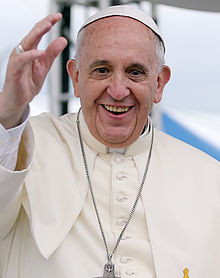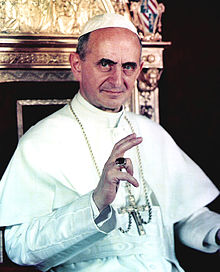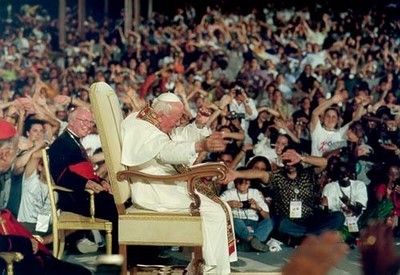Papal visits to the Philippines, in a nutshell. Sort of.

In the eyes of millions of Catholics the world over, there is perhaps no other person– next to Jesus Christ, Himself – more revered than the Pope. The Holy Father is considered the head of the Roman Catholic Church, and successor to Saint Peter. Although humanly appointed, the pontiff is believed to be divinely commissioned to lead the faithful, and serve as the rallying point of their faith. He is, for all intents and purposes, THE Rock Star of Roman Catholicism.
So one can only imagine the hullaballoo and eager anticipation that grips a predominantly Roman Catholic country such as the Philippines in the months, weeks and days leading up to a papal visit: Security preparations are in full swing, itineraries have been mapped, kinks ironed out, and adult diapers purchased for every traffic enforcer and police person assigned to papal detail. Sound s like a joke, you say? Nope. The diapers are mandatory. The powers that be have spoken thusly.
Humour aside. Pope Francis’ upcoming visit to the Philippines is as highly touted as it is highly regarded. He comes with a message of mercy and compassion; and aims to bring hope to scores of Filipinos affected by natural disasters so notorious on these 7,107 islands. On his agenda: Masses, motorcades, prayer rallies, speeches, meals with the downtrodden and impoverished, and a trip to Yolanda-devastated Palo in the Tacloban City.
The Philippines waits with baited breath.
Third Pope’s a charm
Pope Francis – definitely among the more controversial of popes; on account of his often non-traditional views – is the third Pope to visit the Philippines.
The first papal visit was in November of 1970, when Pope Paul VI stepped off the Alitalia plane and onto Philippine soil. He almost did not live to tell the tale. A would-be assassin lay in wait for him on the tarmac of the Manila International Airport.
Pope John Paul II visited the Philippines twice within his 27-year rule as Supreme Pontiff. His first mission to the country was in February of 1981. He returned in January 1995; during which his life was almost put in jeopardy.
The current pope will be the third Holy Father to visit the nation, but his trip marks the fourth papal mission to the country in a span of four and a half decades.

A murder attempt, a karate chop, and a deathbed confession
The arrival of Pope Paul VI in the Philippines was momentous, in more ways than one. Paul VI’s trip was the first time since 1809 that a pontiff would travel outside of Italy. It was also the first time for a pope to visit the Western Hemisphere, Africa, and Asia during his rule. Paul VI visited six continents, and was given the moniker “Pilgrim Pope.”
His visit to the Philippines was momentous also because as soon as the pontiff disembarked from the plane and stepped onto the tarmac of the country’s international airport on November 27, 1970, he was attacked with a knife by Benjamín Mendoza y Amor Flores, a Bolivian surrealist painter. In a stroke of art imitating life, the moment was more than a touch surreal; as Mendoza, dressed as a priest, lunged with his blade at Paul VI.
Making it even more surreal was then President Ferndiand Marcos’ claim that he was “used as God’s instrument “ to save the pope’s life. Marcos claimed to having dealt the would-be assassin a “karate chop” to the hand, causing Mendoza to drop the knife. This claim is based upon an entry of the former president into his personal diary; currently on display – along with other memorabilia of past papal visits – at the Malacañang Palace Museum.
The rest of the trip went smoothly; during which Paul VI spread his message of mercy and compassion – much as Francis is poised to do – and to uplift the faith of Catholics in the country.
“The object of our visit to Manila is of the spiritual order; it has an apostolic character. Great would be our joy if by our visit the Catholic people were made firm in their faith and in the sincere and coherent expression of it,” Paul VI was quoted as saying, in one of many speeches during his trip.
Paul VI declined an invitation to stay at the Palace; choosing, instead, to maintain the tradition of residing at the Apostolic Nunciature in Manila.
What many people may not know – and again, it is a touch surreal – is that Paul VI’s attacker, although unsuccessful, did not entirely miss his target. Mendoza managed to injure the pope; wounding him in the chest area. Paul VI went about with business, as usual, and told no one of what had happened. It is said that he made the revelation on his death bed; fearing that if he had spoken of it any sooner, his attacker would have been meted the death penalty for his actions against the high-profile world leader.
Pope Paul VI, who died in 1978, has been proclaimed a Servant of God and has also been accorded the title of Venerable. He was beatified on October 19, 2014.


Two times Totus Tuus equals one protomartyr and a mammoth youth rally
Totus Tuus was the apostolic motto – Latin for “totally yours” – of Pope John Paul II, who came to the Philippines on two separate occasions. With this motto, John Paul II expressed his personal consecration to Mary, as well as his devotion to the people. History records him as the “most beloved” of all popes.
John Paul II traveled to 129 countries; a total of 1,500 trips and 1-Million kilometres, in all. This made him the “most traveled “ pope.
Unbeknownst to many, John Paul II made three trips to the Philippines. His first ever visit was in 1976, as Kraków Archbishop Karol Cardinal Wojtyla.
His first official visit to the Philippines, as pope, was in February of 1981. John Paul II came to the country for the beatification of Lorenzo Ruiz, the nation’s patron and first-ever saint (or, protomartyr; to be precise) to be venerated by the Roman Catholic Church. The visit went without hitch.
During that trip, he addressed the youth, spoke with the urban poor, and beatified Ruiz and other martyrs who were persecuted in Japan in the 17th century. The ceremony, which was held in Rizal Park, was the first beatification outside of Rome in all of history.
John Paull II also celebrated Mass in the Queen City of the South, Cebu; as well as in Davao City. While in Davao, he met with Muslim leaders.
As part of his itinerary, John Paul II made a trip to Bataan, during which he visited a camp for Vietnamese, Laotian and Cambodian war refugees. He also met with a group of lepers in Manila.
He was accessible to, loved and embraced by Filipinos from nearly all walks of life.
On his second official visit, in January of 1995, the then 74-year-old pontiff was greeted at the Manila International Airport by thousands upon thousands of supporters.
“The Filipino people are never far from my mind and heart,” John Paul II said on his arrival; to exuberant cheers of “Mabuhay!” and “Viva il Papa!”
His second time coming to the country (to preside over the Catholic youth festival, the 10th World Youth Day, from the 10th-15th of January), however, wasn’t so seamless.
On January 15, Al-Qaida terrorist Ramzi Yousef (who was later on convicted for the 1993 attack on the World Trade Center) had intended to plant a bomb underneath a manhole cover along Quirino Boulevard, where he believed the Pope was scheduled to pass en route to a large outdoor Mass. It was an assassination attempt gone wrong, as the bomb exploded prematurely in the sink of an apartment Yousef had rented to serve as headquarters while plotting his dastardly deed.
Apart from an improvised explosive device with a mind of its own, and the fact that John Paul II did not travel by Popemobile to Qurino Grandstand (he flew there via chopper), as Yousef had thought, the plot – which was part of the three-phase terror-driven “Bojinka Plot” – was pretty elaborate. Yousef rented a beach house, for the purpose of training his compatriots for the attack, purchased props (such as Bibles, a crucifix, and a large poster of the Pope), and several priests’ vestments.
Nonetheless, the youth rally went swimmingly. It was the first time for an Asian country to host the event. Additionally, the 5th and final day of the conference drew a record-breaking, mammoth crowd of 4-million people in attendance at the three-and-a-half hour Mass.
Aside from encouraging the youth to pursue God’s will, John Paul also decried poverty and oppression; condemning the injustice in the country, as he referenced what he noted as the “increasing” gap between rich and poor.
“When powerful interests promote policies which are against the moral law inscribed on the human heart, they offend the dignity of man who is made in the image and likeness of God. In doing so, they undermine the foundations of society itself,” he said.
Pope John Paul II reigned 25-years as Pope, until his death in April 2005. He was proclaimed Venerable on December 19, 2009, beatified on May 1, 2011, and canonised on April 27, 2014.
A security nightmare and a stern warning
Yes; with just under two days to go – at the time of this writing – before the arrival of Pope Francis, the Philippines waits with baited breath.
And, quite possibly, the sensation of a stomach full of butterflies.
The trip has repeatedly been described as a potential “security nightmare,” and has everyone and their uncles’ uncle on their toes.
On Monday, three days before Francis’ arrival on January 15, President Benigno Aquino asked a rhetorical question, meant to serve as a reminder bordering on stern warning: “I ask you, do you want history to record that a tragedy involving the pope happened in the Philippines?”
Most certainly not.
Maybe history will record that a law requiring cops and traffic enforcers to don adult diapers was a stroke of genius, after all.